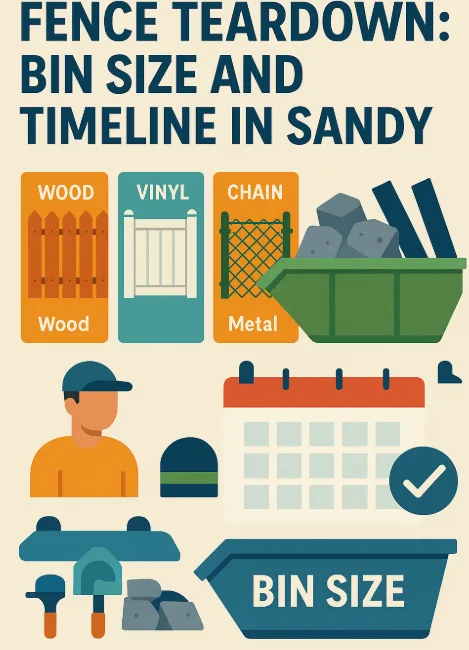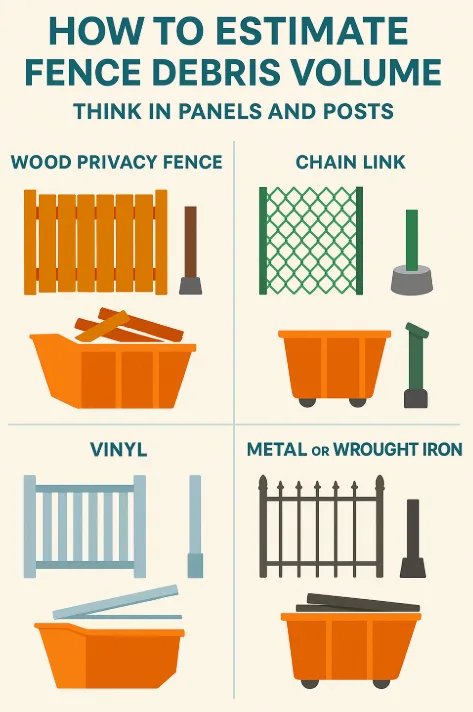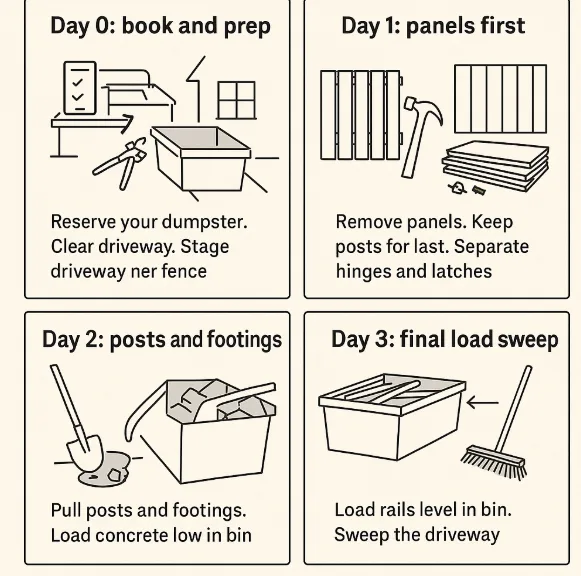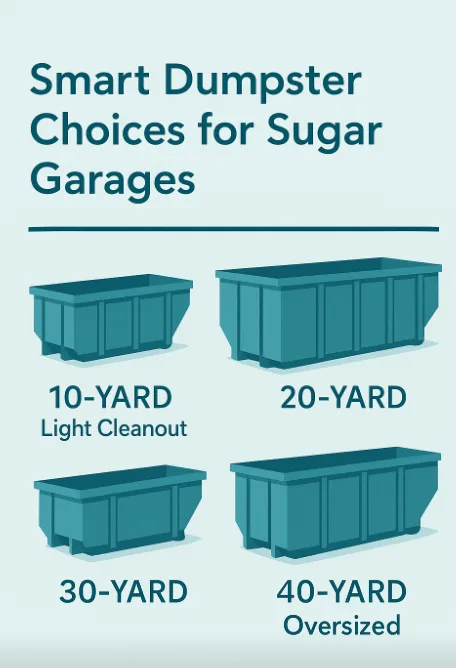Fence Teardown: Bin Size and Timeline in Sandy
Taking down an old fence in Sandy means two things matter most: picking the right dumpster size and setting a clear timeline. The right bin keeps debris under control, while a solid schedule keeps your crew moving without delays.
Whether your project involves wood, vinyl, chain link, or metal fencing, the process also includes hauling away posts and concrete footings. A clear size chart, day-by-day plan, and local disposal tips make the work easier, help you follow city rules, and keep costs reasonable.

Why bin size matters for a fence teardown in Sandy
The bin size shapes your whole job. Pick too small and you call for a second haul. Pick too big and you pay for space you do not use. The right size keeps the driveway clear, protects your timeline, and avoids overweight fees. The right fit also helps you follow Sandy placement rules on streets and driveways. Sandy allows dumpster use by reservation and has specific placement guidance for street or driveway setouts. City guidance notes that dumpsters can go on the street or private property, and winter can change placement due to snow removal. Always check your address and the city’s current notes before delivery.
A properly sized dumpster helps you keep costs down and finish your cleanout without unnecessary delays.
How to estimate fence debris volume
Think in panels and posts.
- Wood privacy fence: A typical 6-foot-tall, 100-linear-foot wood fence produces about one small bin worth of boards, rails, and posts. Many posts have concrete at the base.
- Chain link: Mesh rolls tight but posts often have large concrete plugs.
- Vinyl: Rails and pickets are light but long. They use space fast.
- Metal or wrought iron: Heavier pieces stack tight but can add weight quickly.
A fast way to plan is to measure linear feet, count panels, and note post bases. If you have lots of concrete, move up one bin size for space and weight.

Important Details to Check Before You Book Weight
Wood is lighter than concrete. Vinyl is light but bulky. Chain link is light, but posts and gates add weight. Ask for the ton cap for each size, and keep concrete weight in mind.
Material type
Fence wood, vinyl rails, chain link mesh, metal gates, and concrete footings go in mixed trash bins. Hazardous wastes are not allowed. Paint, solvents, and similar items must go to household hazardous waste programs, not into roll-offs. Salt Lake County has a Household Hazardous Waste facility with posted hours and contact info.
Rental period
Most Sandy jobs finish in 3 to 5 days. Many rentals run 7 days with options to extend. Book the bin to arrive the day before you start. That keeps your crew working.
Placement
Driveway placement is common. If you need the street, Sandy policy regulates occupying the public way. Use city standards and request permission where required.
Rules and drop-off sites
Regular fence debris goes to the Salt Lake Valley Landfill. The landfill posts hours and pricing and lists accepted materials. Hazardous wastes go to the County’s HHW facility or other approved options.
Dumpster size chart for Sandy fence projects
Dumpster Sizes: | Ideal For: |
10-yard | Light debris, chain link fencing without concrete. |
20-yard | Mixed fencing materials, chain link fence with standard concrete plugs. |
30-yard | Large fencing projects with heavy concrete footings, along with yard waste. |
40-yard | Very long fence lines or multi-side teardowns |
If you plan to pull and keep concrete attached to posts, move one size up. Concrete weight adds up fast at the scale.

Simple timeline for a fence teardown in Sandy
Day 0: book and prep
Reserve your dumpster. Choose driveway placement when possible. If you must use the street, confirm city rules for occupying the public way. Clear cars from the driveway. Stage tools near the fence line.
Day 1: panels first
Start at a corner. Remove panels or mesh first. Stack flat. Keep posts for last. Keep a small pile for scrap metal like hinges and latches.
Day 2: posts and footings
Pull posts. If the footing is small, lift the plug. If it is large, cut the post and leave the plug if you plan to reset new posts near the old line. Load concrete low in the bin for balance.
Day 3: final load and sweep
Break down long rails so they sit level. Keep the fill line clear. Sweep the driveway. Take photos of bin fill to confirm level and safe load.
Day 4: haul away
Call for pickup once the bin is level and closed. Keep the route clear for the truck.
Most fence teardowns in Sandy fit in a 3–5 day window with one bin. Bigger lines and heavy footings may need a second day for posts.
Safe loading tips that save space and money
- Load concrete first and low.
- Cut rails and posts to fit flat.
- Stack mesh tight.
- Keep the fill line visible on all sides.
- Do not toss paint, oil, or chemicals into the bin.
What Can Go in Your Dumpster and What Cannot
You can place most fence and garage debris in the dumpster. This includes wood boards, rails, vinyl pickets, chain link mesh, gates, hinges, latches, wood posts, metal posts, concrete footings, and even general garage items such as boxes, shelves, small furniture, and tools. All materials should be clean of liquids like oil or fuel before being loaded.
Some items are not accepted in dumpsters and require special disposal. Wet paint, solvents, fuels, pesticides, chemicals, and car batteries are not allowed. Electronics with batteries, tires, and large appliances that contain refrigerants also fall into this category and must be handled through local hazardous waste programs instead of standard disposal.
If your project involves painted trim or attached structures built before 1978, you should review EPA lead-safe rules before cutting or sanding. These guidelines outline when certification is required and how to manage debris safely.
Common mistakes to avoid during Sandy fence teardowns
- Under-sizing the bin
Many crews start with a 10-yard and then need a swap. If you have long lines or concrete plugs, start with a 20-yard. - Overfilling
If debris sits above the rim, the hauler may refuse pickup or add a fee. Keep the load level. - Street placement without checking rules
If you need the street, use Sandy’s guidance on occupying public ways. Ask about time limits and safety cones. - Skipping landfill hours
Arrivals outside posted hours cause delays. The landfill page lists hours and holidays.
The price of the dumpster in Sandy
Our dumpster rentals in Sandy are priced with straightforward, all-inclusive rates. Pricing depends on the size of the dumpster, the rental period, and the weight of the material placed inside. Every rental includes delivery, pickup, and a set weight allowance. Extra days or over-ton charges may apply if needed, and we make sure all pricing is clear up front.
A 10-yard dumpster rental starts at $350. A 20-yard dumpster rental starts at $400. A 30-yard dumpster rental starts at $450. A 40-yard dumpster rental starts at $500.
When you book with us, you’ll always receive a clear quote that shows the dumpster size, the rental period, the included tonnage, and the rate for any potential overages.
Picking a Bin Size for Your Fence Type
- Wood Privacy or Picket
Wood panels stack flat, but posts often have concrete plugs that add bulk. A 20-yard dumpster fits most 80–150 foot lines. If you’re removing larger plugs or combining with extra debris, a 30-yard gives more room. - Chain Link
Chain link mesh rolls tight, though the posts are usually set in heavy concrete. A 20-yard works well for most lines. If you’re pulling many deep plugs, a 30-yard provides the extra capacity and weight allowance you’ll need. - Vinyl
Vinyl fencing is lightweight but bulky because of long rails and panels. A 20-yard covers most two-side yards. Cutting rails to size makes loading easier and helps maximize the space. - Metal or Wrought Iron
Metal fencing is heavy, so load it low and balanced. A 20-yard is often enough, but a 30-yard is better for longer runs or multiple heavy sections.
FAQs: Fence teardown bins and timing in Sandy
How do I know which fence materials add the most weight to my dumpster?
Concrete footings are the biggest weight driver, followed by saturated lumber, wet soil stuck to posts, mixed rock or gravel backfill, and heavy metal sections. Chain link mesh is light, but the metal posts with concrete plugs add up quickly. Vinyl is light by volume, but long rails can reduce packing efficiency if they are not cut down.
How many concrete plugs can I load before a 20-yard bin risks hitting its ton cap?
As a planning rule, small to medium plugs can average roughly 60 to 100 pounds each depending on diameter and depth. A few dozen plugs can approach one to two tons on their own. If you expect more than about 25 to 35 concrete plugs, consider a 30-yard bin or plan for a swap-out to avoid overages.
When should I step up from a 20-yard to a 30-yard for a wood or chain link fence?
A 20-yard fits most 80 to 150 foot runs if plugs are modest. Move to a 30-yard when the line exceeds 150 feet, when you are pulling deep or oversized plugs, or when you are combining fence debris with other heavy materials like brush piles, soil, or demolition scraps.
What is the best way to load the dumpster to control weight and maximize space?
Knock soil off posts before loading, tap loose concrete where safe, cut long rails so panels sit flat, and stack materials level from front to back. Keep heavy items low and spread out to maintain balance. Avoid heaping above the rim since level loads are required for safe hauling.
How do I plan a three to five day teardown so one bin is enough?
Use the first day for panels and rails, cutting long pieces to fit tight. Use the second day for posts and setting aside any oversized plugs. Use the third day for concrete removal and site cleanup. Add buffer time if you expect many deep footings or need to coordinate utility locates.
Choosing the Right Bin and Timeline for Your Sandy Fence Project
For most fence removals in Sandy, a 20-yard dumpster offers the best balance of space and weight capacity. This size handles standard wood or chain link fences and leaves room for posts and moderate amounts of concrete. When the line stretches beyond 150 feet or involves multiple deep concrete plugs, stepping up to a 30-yard bin prevents overages and keeps the project moving.
Hazardous materials require special handling. Household paints, solvents, fuels, and chemicals should be taken to the County’s household hazardous waste site, not the dumpster. If the project touches painted trim or structures built before 1978, follow EPA lead-safe guidelines to prevent risks from older coatings.

Ready to Start Your Fence Teardown in Sandy?
Reclaiming your yard starts with the right bin size and a solid plan. Our team provides fast delivery, clear pricing, and help with choosing the right container for your project. Whether you need a 20-yard for a typical teardown or a 30-yard for heavier work, we make the process simple from start to finish.
Book your dumpster today for reliable service in Sandy, Utah, and keep your fence project on track.
